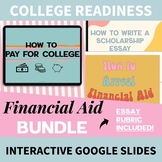Financial Literacy - How to Pay for College, Financial Aid, FAFSA
- PDF
- Google Apps™

What educators are saying
Also included in
- Calling all high school AVID, Advisory, and college and career readiness teachers and counselors! Need help preparing your students for the college application and admission process? Save yourself time with these engaging NO-PREP Google Slides lessons, activities, worksheets, projects, and checklistPrice $97.20Original Price $121.50Save $24.30
- Attention all high school educators counseling or teaching in an AVID, Advisory, life skills, or other college and career readiness programs! If you're feeling a little lost or stressed coming up with lessons and activities for your college and career readiness curriculum, I got you!Save yourself prPrice $217.80Original Price $272.25Save $54.45
- Did you know students and parents say paying for college is their top worry? Teach your high school juniors and seniors financial literacy, including how to pay for college, how to appeal financial aid, budgeting for college, and how to write a scholarship essay with this interactive Google Slides bPrice $23.00Original Price $28.75Save $5.75
Description
Need help demystifying the financial aid and FAFSA process for your students?
Use this engaging interactive Google Slides lesson on how to pay for college to teach your students crucial financial literacy including understanding financial aid and its various sources, exploring different types of financial assistance, and exploring the cost of college attendance and the FAFSA process.
WHAT'S INCLUDED (a complete lesson that uses the 5E Learning Cycle!):
- Engage: Question to hook students.
- Explore: Question to activate prior knowledge and the chance to ask questions before getting into the lesson.
- Explain: In this lesson, students learn:
→ What financial aid is
→ Sources of financial aid
→ Types of financial aid
→ The cost of college attendance - Elaborate/Extend: The extension part of this lesson includes comprehension and discussion questions and an assignment asking students to interview others about how they paid for college.
- Evaluate: Reflection questions at the end of the presentation.
- Extra: Ideas for engaging students and extending the lesson further!
⭐️ This presentation can be used by teachers or counselors with face-to-face instruction, distance learning, OR a hybrid approach in any secondary class. You can present the lesson to the whole class or have students review it themselves in small groups!
⭐️ This is the perfect lesson for a high school AVID, advisory, CTE, life skills, or language arts class! You could also use this presentation during a parent night.
⭐️ Click HERE for the Pear Deck version of this same lesson!
⭐️ This product is a COMPLETE LESSON in one place (similar to a Hyperdoc, which takes students through the learning cycle in one doc or slide deck using hyperlinks and other media). Perfect for using as a differentiated, self-paced, student-centered lesson, and/or whole-class presentation!
⭐️ The time it takes for the entire lesson will vary depending on how much time you allow for group discussions, follow-up class sharing, and extension activities. You could spend as little as 45 minutes on the presentation itself, if that's all the time you have, or one to three whole classes or more if you include some of the suggested extension activities. For ESL classes, you may need a little need more time.
Note: You can skip or delete any of the slides you don't want to use and add your own notes to any of the slides.
Disclaimer: These slides were last updated in 2023. The FAFSA and the financial process is always changing. Please do your own research to stay current. Note that beginning in the 2024-25 Award Year, the FAFSA Simplification Act requires that schools transition from the Expected Family Contribution (EFC) to the Student Aid Index (SAI). The SAI is a number that determines each student’s eligibility for certain types of federal student aid.
This lesson has it all:
-Explicit instruction
-21st-century skills
-Multi-modalities
-Hands-on learning
-Differentiation
-Scaffolding
-Higher levels of questioning
-Real-life connection
-Student choice
IF YOU LIKE THIS PRODUCT AFTER PURCHASING IT, PLEASE GO TO YOUR TPT PURCHASES AND LEAVE ME A REVIEW AND EARN TPT CREDITS! AND BE SURE TO FOLLOW ME ON TPT FOR UPDATES ON NEW PRODUCTS!
⭐️ You might also like:
Financial Aid BUNDLE (includes this product)
⭐️ Get this FREE College and Career Readiness Curriculum Planning Guide and this FREE 9th-Grade AVID Pacing Guide on my website!
⭐️ Get in touch by using this form HERE.
⭐️ Check out my other products on TPT and find out when I make new products (be sure to follow!): Jenn Liu: Engaging to Empower
Aloha,
Jenn
Copyright © Jenn Liu
Permission to use for single classroom use only.
Please purchase additional licenses if you plan to share this product with other teachers.








